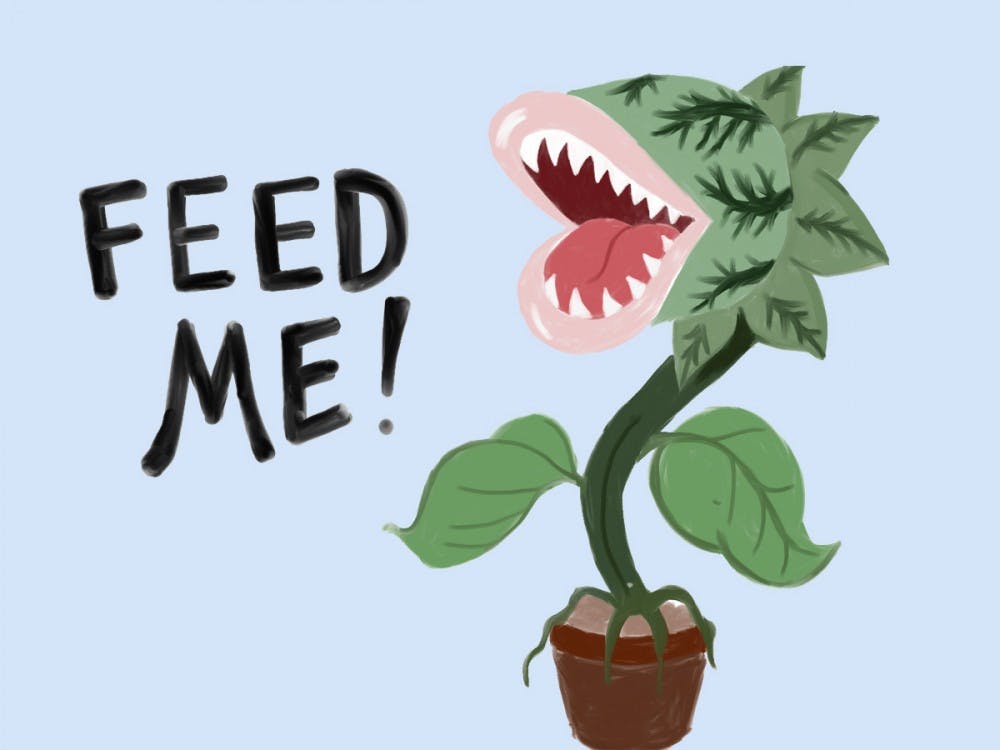There are few title sequences that top the opening to the 1986 film “Little Shop of Horrors.” The scrolling bold text across a starry night sky and the fanfare of rock organ and electric piano blatantly spoofs the opening crawl from the Star Wars films. The narrator reminds me of Bobby Pickett, the comedian who sang the novelty Halloween hit, “Monster Mash,” and he introduces the film with these enigmatic words:
“On the 23rd day of the month of September, in an early year of a decade not too long before our own, the human race suddenly encountered a deadly threat to its very existence. And this terrifying enemy surfaced as such enemies often do – in the seemingly most innocent and unlikely of places.”
I recently rewatched “Little Shop of Horrors” on that date, Sept. 23. When I first saw the film, I immediately fell in love with its cheesy music, bright visuals and dark comedy. In any other context, the film’s premise would be absolutely terrifying: A plant from outer space demands human flesh from a geeky florist. Yet, the film is so memorable because of its absurdness. It’s a staple in the horror comedy genre, with other campy titles like “The Rocky Horror Picture Show” or even “Buffy the Vampire Slayer.”
Rick Moranis stars as Seymour, an orphan working in Mr. Mushnik’s Skid Row Flower Shop. He pines after his coworker Audrey, played by Ellen Greene, who is trapped in an abusive relationship with a sadistic dentist. During a total solar eclipse, Seymour discovers a strange, unearthly plant and names it Audrey Two. What’s strange is that the plant only consumes human blood, not sunlight or water. As Audrey Two rapidly grows, it attracts attention to the flower shop, making Seymour a celebrity. Audrey Two demands that Seymour murder Audrey’s boyfriend as plant food. This dilemma is the root of Seymour’s eventual descent into madness.
In homage to the 1982 off-Broadway musical, every stage movement in “Little Shop of Horrors” is sharp and intentional, adding to the film’s cheesy aesthetic. The characters constantly break the fourth wall with absurd visual gags and jump cuts. Alan Menken, the genius behind many Disney movie musicals, composed the soundtrack, which is inspired by rock and roll, Motown and doo-wop. Crystal, Ronette and Chiffon (named after popular 60s girl groups) are the film’s Greek chorus. For the most part, their characters are detached from the plot of the movie, but the three ladies also occasionally portray a trio of street urchins living on Skid Row. They provide commentary through musical interludes and background vocals, and their impressive vocal chops make every song a bop.
My favorite number is “Skid Row,” an ensemble piece about life in downtown slums. There’s a powerful shot of the resident bums climbing up a wire fence, trying to escape from the troubles that brought them to Skid Row. Orin Scrivello, D.D.S. (Steve Martin), performs “Dentist!” as an obnoxious Elvis Presley. There’s a shot during the song that places the camera inside a patient’s mouth, which frames Orin laughing maniacally off of nitrous oxide. Bill Murray’s cameo at the dentist’s office as Arthur Denton, a masochistic patient who comes to see Orin, is perhaps the best scene in the movie. Since Arthur enjoys pain, Orin becomes completely frustrated when he cannot torture Denton properly. It’s hilarious watching a sadist and masochist meet.
In the age of nostalgic movie remakes, I think the world is ready for a new retelling of “Little Shop.” The stage musical, first performed in 1982, is currently having an off-Broadway revival, so it seems like it’s the right time for new theatergoers to become familiar with the show. Although many fans think that the film version does not need a remake, I believe that modern audiences would respond favorably to an updated script. Lady Gaga has reportedly been asked to play Audrey for the film reboot, which would be the perfect direction for her acting career. Perhaps Lady Gaga’s interpretation of the character can give the film stronger female representation. In the original, Audrey is a caricature of a ditzy American housewife, and although the film tries to criticize heteronormative stereotypes, there are some moments when it seems like they are being reinforced instead. Giving Audrey more of a backbone would keep the story fresh.
“Little Shop of Horrors” is, at its core, an exploration of human nature. The film asks what man is willing to do for fame or fortune and questions whether committing murder can ever be justified. The conflict between man and alien plant is best demonstrated when Seymour realizes how Audrey Two has derailed his life, admitting, “You’re a monster, and so am I.” By the end of the film, it becomes apparent that Audrey Two is more dangerous than anyone could have ever imagined. The message is clear: Don’t feed the plants, especially when they attempt to eat your flesh.
Get The Chronicle straight to your inbox
Signup for our weekly newsletter. Cancel at any time.

